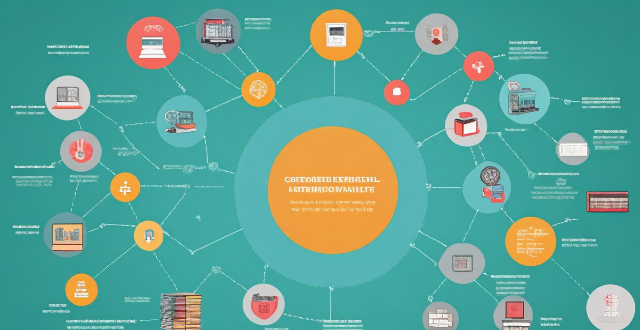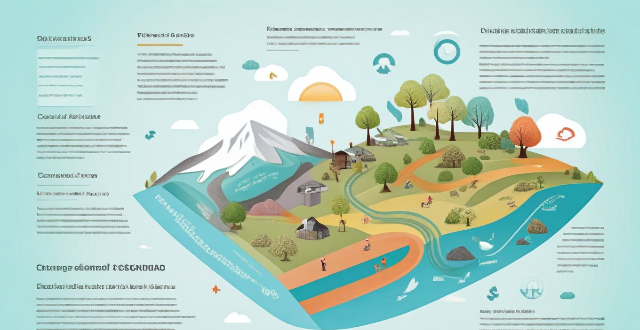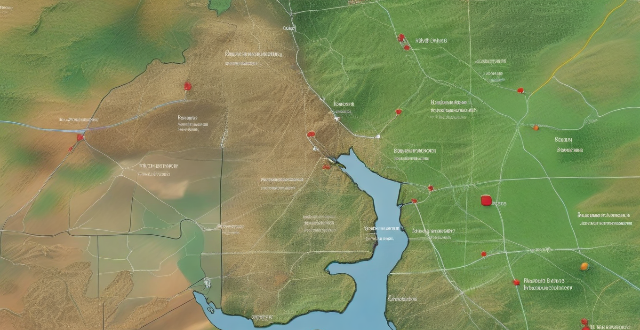Cap Change

How does a carbon tax compare to other climate policies, such as cap-and-trade ?
**Comparison between Carbon Tax and Cap-and-Trade Climate Policies:** **Effectiveness:** - **Carbon Tax**: Depends on tax rate, revenue recycling, and international cooperation. Higher rates may reduce emissions but impact the economy negatively. - **Cap-and-Trade**: Depends on the stringency of the cap, market mechanisms, and offsetting mechanisms. A strict cap can lead to significant emissions reductions. **Economic Implications:** - **Carbon Tax**: Incentivizes innovation, impacts consumers (especially low-income households), and can stimulate economic growth through green technologies. - **Cap-and-Trade**: Introduces cost uncertainty, risks market manipulation, and can create jobs in new technologies and industries related to emissions reductions. **Implementation Challenges:** - **Carbon Tax**: Faces political opposition, equity concerns, and requires international coordination for maximum effectiveness. - **Cap-and-Trade**: Requires complex setup and management, strict enforcement, and may face public opposition if perceived as legitimizing pollution. **Conclusion:** Both policies have pros and cons in addressing climate change. The choice often depends on political feasibility, economic considerations, and public acceptance. What's crucial is taking effective action to reduce greenhouse gas emissions.

How do ecological taxes compare to other environmental policies, such as cap-and-trade systems ?
The text discusses the comparison of two environmental policies: ecological taxes and cap-and-trade systems. It explains what these policies are, their advantages, disadvantages, and concludes that the choice between them depends on political feasibility, administrative capacity, and public acceptance.

What is the relationship between the greenhouse effect and ice caps melting ?
The greenhouse effect, amplified by human activities, leads to global warming which causes ice caps to melt, leading to sea level rise, climate change, and ecosystem disruption.

How does climate change impact national security ?
Climate change impacts national security in various ways, including economic disruption, social unrest, and political instability. To mitigate these effects, it is essential to take action at both the national and international levels, such as reducing greenhouse gas emissions, investing in renewable energy sources, and adapting to the inevitable changes brought about by climate change.

What is the carbon trading market ?
The carbon trading market is a financial mechanism that allows for the trading of emissions reductions to meet greenhouse gas emission targets. It is based on cap-and-trade, where a limit is set on total emissions and those who reduce their emissions below the cap can sell their surplus allowances. Key components include carbon credits, emissions caps, trading mechanisms, verification and certification, and regulation and governance. Benefits include cost-effectiveness, flexibility, innovation incentives, and global collaboration. Challenges and criticisms include equity concerns, market inefficiencies, environmental integrity, and political will. The carbon trading market serves as a crucial tool in the fight against climate change but requires ongoing attention and improvement to maximize its effectiveness.

How do emission trading schemes work and are they effective ?
Emission trading schemes are market-based mechanisms designed to regulate the release of pollutants, especially greenhouse gases like CO2. These schemes operate on a "cap and trade" principle, whereby a regulatory body sets a limit on emissions, allocates emission allowances, and allows businesses to buy and sell these allowances in a marketplace. Companies must monitor and report their emissions, facing penalties for non-compliance. The effectiveness of such schemes varies but offers advantages like cost-efficiency, flexibility, and innovation incentives. However, challenges include complexity, political will, leakage, and equity concerns. Case studies like the EU ETS and California's Cap-and-Trade Program show mixed results, indicating that while emission trading schemes can be effective, their success depends on careful planning, robust implementation, and continuous evaluation.

Can you explain the concept of market capitalization and its significance in stock analysis ?
Market capitalization is a crucial financial metric that reflects the total dollar value of a company's outstanding shares. It is calculated by multiplying the current market price per share by the total number of outstanding shares. Market cap helps investors and analysts assess a company's size and potential growth opportunities, serving as a fundamental tool in stock analysis. Large-cap stocks represent well-established companies, while mid-cap and small-cap stocks indicate potential for growth but come with higher risks. Market cap also influences investment strategies, such as diversification and index fund investing, and is used in valuation metrics like P/B and P/E ratios. Understanding market cap allows for informed decisions on portfolio construction, risk management, and valuation assessments.

How can climate and environmental policies be adapted to address the challenges posed by climate change ?
To address the challenges posed by climate change, climate and environmental policies must be adapted to ensure they are robust, flexible, and capable of meeting the evolving needs of our planet. This can be done by setting clear and ambitious targets for reducing greenhouse gas emissions and developing strategies for adapting to the impacts of climate change that cannot be avoided. Promoting renewable energy sources, improving energy efficiency, investing in research and development, encouraging sustainable land use, strengthening international cooperation, educating the public and raising awareness, establishing carbon pricing mechanisms, and preparing for climate-related risks are also key steps. By adopting these measures, we can work together towards a sustainable future.

How does the carbon trading market work ?
The carbon trading market is a mechanism designed to reduce greenhouse gas emissions by providing economic incentives for their reduction, operating on the principle of "cap and trade." It involves setting a cap on the total amount of greenhouse gases that can be emitted by regulated entities, who can then buy and sell allowances or credits for emissions. The process includes establishing the cap, allocating allowances, trading allowances, banking allowances, offsetting emissions through projects, verification and certification, regulation and oversight, and dealing with benefits and criticisms.

What are the key provisions of the latest climate change legislation ?
The latest climate change legislation is a comprehensive package of measures aimed at addressing the challenges posed by global warming and climate change. The key provisions include reduction of greenhouse gas emissions, adaptation to climate change impacts, international cooperation and leadership, just transition for workers and communities, and transparency and accountability.

What is the role of national governments in implementing climate change policies ?
The role of national governments in implementing climate change policies is crucial. They are responsible for developing and enforcing laws, regulations, and policies that address the causes and consequences of climate change. This involves a wide range of actions, from reducing greenhouse gas emissions to adapting to the impacts of climate change. National governments have several key responsibilities when it comes to climate change, including legislation and regulation, international cooperation, funding and support for sustainable development, public awareness and education, and encouraging private sector involvement. Examples of national government actions on climate change include setting renewable energy targets, implementing carbon pricing mechanisms, participating in international climate agreements, and taking adaptation measures.

How can we measure the impact of climate change on a country's economy ?
Measuring the impact of climate change on a country's economy involves considering direct and indirect economic losses, as well as the costs associated with adaptation and mitigation efforts. Key factors include agriculture, infrastructure damage, health costs, ecosystem services, resource depletion, displacement of people, investments in infrastructure, research and development, policy and regulation, transitioning to low-carbon economies, carbon pricing, and international cooperation. Understanding these factors can help policymakers make informed decisions about addressing climate change challenges.

How do climate change negotiations affect global trade and economic systems ?
Climate change negotiations play a crucial role in shaping global trade and economic systems. These negotiations aim to find solutions to the challenges posed by climate change, such as reducing greenhouse gas emissions, promoting renewable energy sources, and protecting biodiversity. The outcomes of these negotiations have far-reaching implications for international trade, investment, and economic development. In this article, we will explore how climate change negotiations affect global trade and economic systems. One of the key impacts of climate change negotiations on international trade is the imposition of tariffs and subsidies on goods and services that contribute to climate change. For example, countries may impose higher tariffs on imported goods that are produced using high levels of carbon emissions or other environmentally harmful practices. Similarly, governments may provide subsidies to domestic industries that adopt sustainable practices or invest in renewable energy technologies. These measures can create trade barriers and distort market competition, affecting global trade patterns. Another way in which climate change negotiations can influence international trade is through the implementation of carbon pricing mechanisms, such as carbon taxes or cap-and-trade systems. These mechanisms aim to internalize the external costs of carbon emissions by making polluters pay for their emissions. As a result, companies that rely heavily on fossil fuels or produce high levels of emissions may face increased costs, making their products less competitive in global markets. On the other hand, companies that invest in low-carbon technologies or adopt sustainable practices may gain a competitive advantage. Climate change negotiations often lead to the adoption of stricter environmental standards and regulations at both national and international levels. These standards can affect international trade by creating compliance costs for exporters and importers. For instance, companies that export goods to countries with stringent environmental regulations may need to invest in cleaner production processes or face penalties for non-compliance. Similarly, importers may prefer to source goods from suppliers that meet certain environmental standards, affecting trade flows and market access. Climate change negotiations also have significant implications for investment and economic development. As countries commit to achieving ambitious climate targets, there is an increasing demand for green finance and investment in sustainable projects. This can create new opportunities for investors and businesses that focus on renewable energy, energy efficiency, and other low-carbon sectors. However, it can also lead to capital flight from traditional fossil fuel industries, affecting economies that rely heavily on these sectors. Climate change negotiations often include provisions for technology transfer and innovation cooperation between developed and developing countries. This can help bridge the gap between countries with different levels of technological capabilities and promote sustainable development worldwide. By facilitating the transfer of clean energy technologies and supporting research and development efforts, climate change negotiations can foster economic growth and job creation in emerging markets. Finally, climate change negotiations address the urgent need for adaptation financing and support for vulnerable communities affected by climate change. This includes funding for infrastructure improvements, disaster risk reduction, and other measures that help countries adapt to changing climate conditions. While these efforts are essential for protecting human lives and livelihoods, they also represent significant economic opportunities for businesses involved in climate resilience and adaptation services. In conclusion, climate change negotiations have far-reaching implications for global trade and economic systems. By imposing tariffs and subsidies, implementing carbon pricing mechanisms, setting environmental standards, promoting green finance and investment, facilitating technology transfer and innovation, and providing adaptation financing and support, these negotiations shape the future direction of international trade and economic development. As we continue to grapple with the challenges posed by climate change, it is crucial for policymakers, businesses, and civil society to work together to ensure that our responses to this global challenge are aligned with our collective goals for sustainable prosperity.

What is green finance and how does it relate to climate change ?
Green finance is the financing of projects that have environmentally friendly impacts, such as reducing carbon emissions or conserving natural resources. It involves investing in renewable energy sources, clean technologies, and sustainable infrastructure projects that aim to mitigate climate change and promote a greener economy. The relationship between green finance and climate change includes impact on carbon emissions, promotion of sustainable practices, innovation and technology development, risk management and resilience, market incentives and policy support, stakeholder engagement, and international cooperation. Green finance plays a crucial role in addressing climate change by directing capital towards environmentally beneficial projects and practices.

How does sustainable development contribute to the fight against climate change ?
Sustainable development is crucial in the fight against climate change. It aims to balance economic growth, social inclusion, and environmental protection. Mitigating climate change involves transitioning to renewable energy, improving energy efficiency, and developing green infrastructure. Adaptation strategies include sustainable agriculture, water management, and coastal protection. Social equity and environmental justice are also key, with access to clean energy, healthy communities, and climate education being vital. Policy and governance play a significant role through regulatory frameworks, international cooperation, and public participation. Sustainable development provides a framework for integrating climate action into all aspects of society, ensuring a resilient, equitable future for all.

What actions have countries taken to meet their climate commitments ?
Countries have made commitments to reduce their carbon emissions and mitigate the impacts of climate change. They have taken various actions, including investing in renewable energy sources, improving energy efficiency, implementing carbon pricing mechanisms, focusing on forestry and land use practices, and promoting international cooperation. These efforts demonstrate a collective determination to address the urgent issue of climate change and create a more sustainable future for all.

How does climate change legislation influence corporate sustainability practices ?
Climate change legislation significantly influences corporate sustainability practices by setting standards for environmental responsibility. It compels companies to report on their environmental impact, use market-based mechanisms like cap-and-trade systems, and consider tax incentives or penalties in their operations. This legislation also creates investor pressure through ESG criteria and shareholder resolutions, leading companies to enhance their sustainability practices to meet investor expectations. Additionally, it opens market opportunities for green products and services and encourages renewable energy adoption. Companies that comply with climate legislation can improve their brand image and stakeholder engagement. Furthermore, such legislation aids in risk management by requiring companies to assess physical and transition risks associated with climate change. Overall, climate change legislation is a driving force behind corporations adopting more sustainable practices.

What are the most effective ways to combat climate change ?
Combating climate change requires a multifaceted approach that includes reducing greenhouse gas emissions, promoting renewable energy, adopting sustainable land use practices, improving waste management and recycling, investing in research and innovation, encouraging policy and legislation changes, and raising awareness and education. Transitioning from fossil fuels to renewable energy sources like wind, solar, and hydroelectric power is crucial. Improving the efficiency of buildings, appliances, and transportation can also reduce energy demand and emissions. Reforestation, conservation agriculture, and urban green spaces can help absorb CO2 from the atmosphere. Proper recycling of organic waste and e-waste, as well as adopting a circular economy, can prevent hazardous materials from polluting the environment. Funding research into new technologies that can reduce environmental impact and enhancing our understanding of climate systems through advanced modeling can lead to better predictions and policies. Implementing taxes or cap-and-trade systems to make polluting activities more expensive, setting stricter regulations on emissions, waste management, and resource consumption, and participating in global initiatives like the Paris Agreement are all important steps. Increasing public awareness about the urgency and impacts of climate change through media campaigns, integrating climate change education into school curriculums, and engaging local communities in initiatives such as tree planting, clean-up drives, and sustainability workshops can also make a difference.

How can we mitigate the effects of climate change ?
Mitigating the effects of climate change is a complex and multifaceted challenge that requires a combination of individual actions, technological innovations, and policy interventions. Here are some strategies that can help reduce greenhouse gas emissions and adapt to the changing climate: Individual Actions: - Reduce energy consumption by turning off lights and unplugging electronics when not in use, using energy-efficient appliances, and installing solar panels. - Use public transportation, carpool, or bike to reduce your carbon footprint. - Eat a plant-based diet to reduce your environmental impact. - Support renewable energy sources by advocating for clean energy policies and investing in renewable energy technologies like wind and solar power. - Reduce waste by practicing the three R's (reduce, reuse, recycle) to minimize waste and conserve resources. Technological Innovations: - Develop clean energy technologies such as advanced batteries, nuclear fusion, and carbon capture and storage. - Improve energy efficiency through energy-efficient building designs, appliances, and transportation systems. - Promote electric vehicles and expand charging infrastructure to reduce dependence on fossil fuels. - Implement smart grids to optimize energy distribution and integrate renewable energy sources more effectively. Policy Interventions: - Implement carbon pricing by introducing a tax on carbon emissions or implementing cap-and-trade systems to incentivize businesses and individuals to reduce their carbon footprint. - Enact clean energy policies by establishing laws and regulations that promote the development and use of renewable energy sources and phase out fossil fuel subsidies. - Invest in climate adaptation measures by allocating funds for projects that improve resilience to climate change impacts, such as seawalls, drought-resistant crops, and flood management systems. - Support international cooperation by collaborating with other countries to share knowledge, technology, and resources to address global climate challenges collectively. By taking these individual actions, embracing technological innovations, and implementing effective policies, we can work towards mitigating the effects of climate change and creating a more sustainable future for ourselves and future generations.

Are there any ethical considerations for investors when dealing with companies involved in fossil fuel extraction ?
Investing in fossil fuel extraction companies raises ethical concerns related to environmental impact, social responsibility, governance, and financial risks. Key considerations include the contribution to climate change, pollution, ecosystem damage, indigenous rights, local community health, labor practices, transparency, corruption, stakeholder engagement, regulatory changes, market trends, energy transition, and strategic planning. Investors must weigh these challenges against their values and the broader implications for society and the environment, as the world moves towards decarbonization and greater environmental consciousness.

How has climate change affected polar ice caps and sea levels ?
The polar ice caps are melting due to global warming, causing sea levels to rise and threatening coastal communities and ecosystems. The Greenland and Antarctic ice sheets are losing mass at an accelerating rate, contributing significantly to rising sea levels. This has significant implications for both the environment and human societies around the world. Rising sea levels pose serious threats such as coastal erosion, saltwater intrusion, loss of wetlands and mangrove forests, and displacement of coastal communities. To mitigate these impacts, urgent action must be taken to reduce greenhouse gas emissions and transition to cleaner energy sources.

How does climate change affect education ?
Climate change impacts education through extreme weather events, health issues, food insecurity, economic challenges, social changes, and environmental degradation. These effects necessitate collaboration between educators and policymakers to develop resilient strategies for adapting to climate change.

How effective has the recent climate change legislation been in reducing greenhouse gas emissions ?
The effectiveness of recent climate change legislation in reducing greenhouse gas emissions has been variable, with some regions and policies showing significant success while others face numerous barriers.

How is climate change affecting global temperatures ?
Climate change, largely due to human activities like burning fossil fuels and deforestation, is causing a rise in global temperatures. This has led to more frequent and severe extreme weather events, melting ice caps, ocean warming and acidification, changes in precipitation patterns, impacts on biodiversity, and challenges for agriculture. The situation calls for immediate action to reduce greenhouse gas emissions and adapt to the changing climate.

How do climate model predictions help in mitigating climate change ?
Climate models help mitigate climate change by identifying risks, developing adaptation strategies, formulating mitigation policies, facilitating international cooperation, and raising public awareness. They provide essential information for decision-makers to plan resilient infrastructure, adjust agricultural practices, implement water management strategies, set energy efficiency standards, establish renewable energy targets, and encourage low-carbon lifestyles.

What role do governments play in promoting public climate awareness ?
The article discusses the role of governments in promoting public climate awareness. It suggests that governments can launch education and information campaigns, provide incentives and subsidies, implement regulations and policies, and collaborate with NGOs to raise public awareness about climate change. The article also emphasizes the importance of incorporating climate change education into school curriculums and enforcing stricter building codes to promote sustainability. Overall, the article highlights the crucial role governments play in promoting public climate awareness and encourages them to take action to mitigate the effects of climate change.

How is climate change affecting the insurance industry ?
Climate change is significantly impacting the insurance industry by increasing natural disasters, altering liability exposures, and prompting regulatory changes. Insurers must adapt to these challenges by updating risk assessment models, complying with new regulations, shifting investment portfolios towards sustainability, and innovating products. This adaptation is crucial for insurers' financial resilience and their role in aiding societal adaptation to climate change.

Can energy conservation and emission reduction policies help combat climate change ?
Energy conservation and emission reduction policies are essential for combating climate change. These policies aim to reduce energy consumption, promote renewable energy sources, and decrease greenhouse gas emissions. Improving energy efficiency and encouraging energy conservation can significantly reduce energy consumption. Increasing investment in renewable energy technologies and supporting research and development of clean energy technologies can help reduce reliance on fossil fuels and decrease greenhouse gas emissions. Implementing carbon pricing mechanisms and regulating industrial emissions are also important strategies for reducing greenhouse gas emissions. Overall, these policies play a vital role in mitigating the effects of climate change and working towards a more sustainable future.

What are the main objectives of climate change negotiations ?
Climate change negotiations aim to limit global warming, pursue a 1.5°C target, adapt to impacts, support developing countries, and ensure transparency and accountability in actions.